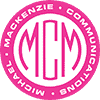A logo is the face of your business. The fonts and colors you choose all play a role in how your company is perceived by the public. Spending time strategically choosing these features now will make branding easier in the future.
Use Fonts and Colors that Reflect Your Business
Fonts
Fonts speak to your potential clients. Most importantly, your font should be appropriate for your industry. For instance, a bank needs strong, reliable lettering to convey security and trustworthiness, not a whimsical, flowing script. Conversely, a children’s boutique would likely engage its target audience with a playful or more scripted font that evokes fun and imagination.
Don’t forget to make sure your font is legible – in all sizes. A font should have appropriate spacing between letters. If you are going to have a tagline with your logo, we suggest you also produce a version without the additional text to use in instances where the tagline would be too small to read.
Colors
Colors evoke an emotional response.
- Red: Authority, urgency, passion, excitement.
- Blue: Calmness, trustworthiness, thoughtfulness, stability.
- Green: Growth, prosperity, nature, freshness.
- Yellow: Lightheartedness, joy, optimism, energy.
Once you identify the main colors for your logo, select secondary colors as well. Not only does this give your logo a pop of color, but it also allows you to have multiple colors that can be used throughout your brand. When picking your colors, remember to avoid colors or combinations that are copyrighted (many large corporations and sports teams have taken this step) and be sure your main colors don’t fade into a background. Yellow, for example, needs to be darker if used for words.
Finally, there are thousands of colors! You aren’t limited to the colors in the crayon box. Using a color swatch book is a great way to visualize how colors in the same hue work together – when you can see 5-6 versions of a color on a page. Looking at a color wheel can also help you quickly identify the best complementary color to your main color. You don’t have to choose a color on the direct opposite side of the wheel from your main color, but it does give you a good starting point.
Ensure Versatility
This step is important! Once you’ve narrowed down your main logo colors, develop a color palette. This palette should include:
- Accent colors
- Lighter and darker versions of your main colors
- Any additional colors approved for text (beyond black or your primary brand colors)
Why is this vital? Your logo is going to be used in many places, from business cards to email signatures to websites. The same accent color you use to outline a feature on your logo may not be the best choice for website design. It may be too bright or too hard to read. However, a darker version of that same color may be perfect for headlines or container backgrounds.
Be Unique and Keep it Simple
Every business wants its logo to be instantly recognizable and memorable. For a small business, stating your company’s function or name in the logo is usually a solid choice. However, adding much more text to the logo dilutes the message and makes it hard to understand. One final word of caution – avoid trendy colors and designs. While they are fun now, you want this significant investment in time and money to stay with your business for the duration!
This blog is courtesy of Account Manager Melissa Holder.



